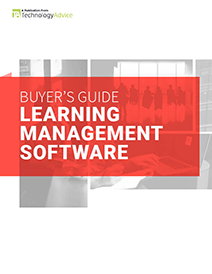This is a guest post from Nikos Andriotis, an e-learning specialist at TalentLMS. Nikos has been involved with tech startups and education for nearly two decades, wearing the hats of entrepreneur, software engineer, and instructor.
_____
From its humble beginnings in the nineties, e-learning has grown to a $120 billion dollar industry that dominates enterprise training. In many ways, e-learning even offers a better experience than traditional classroom-based employee training.
Its on-demand nature, for example, makes e-learning much more convenient than the rigid schedules of classroom-based training. It allows you to centralize training management activity across locations and time zones. E-learning also delivers standardized training, as opposed to letting several individual instructors cover a breadth of material.
READ ALSO: Corporate E-learning Solutions, Challenges, and Trends
These aspects enable e-learning to provide a better experience and give businesses more power and flexibility in their training programs. However, they’re only qualitative benefits. If you want upper management and project sponsors to invest in developing e-learning based training programs, you need quantifiable metrics and hard proof of financial benefits.
So how do you begin to measure the full return on investment (ROI) of automated employee training? Let’s explore several approaches.
Calculate Cost Savings
To measure the ROI from automated employee training, you can wait for the company’s e-learning courses to conclude and then check for a spike in profit or revenue that could be attributed to said training. However, it can be tricky (or near impossible) to exclude additional unrelated factors that may have contributed to these changes.
In that case, the simplest approach to measure ROI is through a cost savings estimation. This is done by calculating the total operating cost of traditional classroom-based training and comparing it to the cost of implementing an equivalent e-learning-based training program.
This method can favor e-learning solutions tremendously because online learning does away with numerous traditional training expenditures, such as:
- Textbooks and training equipment costs
- The cost to rent or reserve a class space
- Transportation and lodging costs associated with off-site training
The savings are especially impressive when automated employee training is deployed at larger companies with multiple facilities and numerous employees to train. In such cases, traditional training costs skyrocket and the logistics involved become difficult to follow.
On the other hand, with automated employee training, a you use a single learning management system to train employees with just a fixed upfront cost (in the case of a private cloud deployment) or a small monthly fee (in the case of a SaaS solution).
Compare Efficacy and Benefits
Of course, the above cost comparison assumes the end product is the same, i.e., that the two approaches to employee training have the same effectiveness. Fortunately, academic research indicates this is indeed the case. A recent study by Imperial College London concluded students acquire knowledge and skills through e-learning as well as or better than through traditional teaching.
While efficacy and ROI in the form of cost savings can be substantial and easy to measure, the larger return on investment from adopting automated employee training can be much more difficult to estimate.
For example, e-learning classes, unlike traditional classroom-based courses, don’t need to be scheduled for specific days and hours. Nor do they necessitate the learner’s physical presence. By allowing learners to study at their own pace, even from home or while commuting, e-learning minimizes business disruption and downtime. In this case, a crude estimation of man-hours saved won’t tell the whole story.
Consider Qualitative ROI
After you cover the basic cost-based comparisons above, evaluate the qualitative (but still related to improved business efficiency) benefits of an e-learning program. While it’s common practice to only measure ROI in direct monetary returns, it’s short-sighted not to include both soft and hard metrics that influence a long-term return on investment.
Employee engagement and satisfaction with a training program directly influences its effectiveness, and, in turn, the company’s bottom line. To measure those, use your LMS reporting and analytics tools to evaluate course attendance, test performance, and overall progress. An employee survey on their automated training program experience will also help gauge employee engagement and satisfaction.
Another option is to leverage your HR department to evaluate employees who have taken e-learning courses. To do this, test their knowledge and skills acquisition as if they were new hires. Use interview questions and task assessments to check their progress by comparing the proficiency with their pre-course skills or initial hiring interview results.
Of course, there are additional ways to measure improvements gained from e-learning programs. Assuming your company already tracks a plethora of operation and performance metrics (and in this era of big data, that’s a safe guess), compare them before and after a course to indirectly measure the impact of your e-learning program.
If you train support center operators, for example, then you would contrast the number of successful resolutions of customer issues per day before and after the training. You can statistically compare anything that you keep measurements for and that training should improve.
View Training as a Long-term Investment
E-learning is effective, flexible, consistent, and data rich. Besides the cost-savings related to classroom-based training, e-learning doesn’t always have an obvious positive result on the bottom line. But in reality, e-learning isn’t really that different from traditional training: It’s not as much a method for revenue-building, but a long-term investment in your company’s health. Invest in your people and their skills, and your company becomes better equipped to fight against competitors, as well as market and industry changes.
Top Human Resources Software Recommendations

